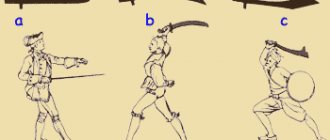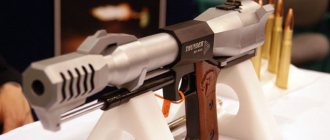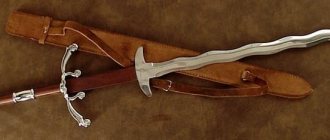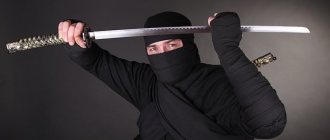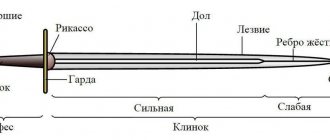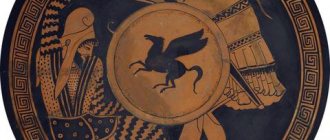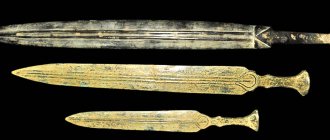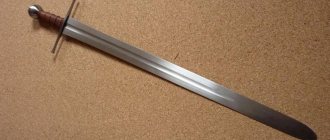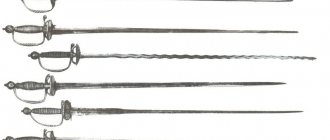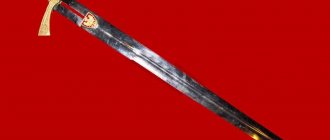Sword. Of course, it is the most famous and revered type of bladed weapon. For several thousand years, the sword not only faithfully served many generations of warriors, but also performed the most important symbolic functions. With the help of a sword, a warrior was knighted; it was necessarily one of the items used during the coronation of European crowned persons. The good old sword is still widely used in various military ceremonies and no one even thinks of replacing it with something more modern.
The sword is widely represented in the mythology of various peoples of the world. It can be found in Slavic epics, Scandinavian sagas, the Koran and the Bible. In Europe, the sword was a symbol of the status of its owner, distinguishing a noble person from a commoner or slave.
However, despite all the symbolism and romantic aura, the sword was primarily a melee weapon, the main function of which was to destroy the enemy in battle.
The medieval knight's sword resembled a Christian cross; the arms of the cross formed a right angle, although this did not have much practical significance. Rather, it was a symbolic gesture that equated the knight's main weapon with the main attribute of Christianity. Before the knighting ceremony, the sword was kept in the church altar, purifying this murder weapon from filth. During the ritual itself, the sword was given to the warrior by the priest. Pieces of sacred relics were often placed in the hilts of combat swords.
Contrary to popular belief, the sword was not the most common weapon either in ancient times or in the Middle Ages. And there are several reasons for this. Firstly, a good fighting sword has always been expensive. High-quality metal was scarce and expensive. Making these weapons took a lot of time and required highly skilled blacksmiths. Secondly, wielding a sword at a high level required many years of hard training; learning to wield an ax or spear was much easier and faster. The future knight began to be trained from early childhood...
Various authors provide excellent data on the cost of a combat sword. However, one thing is certain: its price was high. In the early Middle Ages, the price for an average blade was equal to the cost of four cows. An ordinary one-handed sword made by a famous master was even more expensive. The weapons of the highest nobility, made of Damascus steel and richly decorated, cost fabulous amounts of money.
This material will give the history of the development of the sword, from ancient times to the late Middle Ages. However, our story will mainly concern European weapons, because the topic of bladed weapons is too broad. But before moving on to a description of the main milestones in the development of the sword, a few words should be said about its design, as well as a classification of this weapon.
Anatomy of a sword: what the weapon consists of
A sword is a type of bladed weapon with a straight, double-edged blade, designed to deliver slashing, slashing and piercing blows. The blade takes up most of the weapon; it can be more suitable for delivering slashing or, conversely, piercing blows.
For the classification of bladed weapons, the shape of the blade and the method of sharpening it are very important. If the blade has a bend, then such a weapon is usually classified as a saber. For example, the well-known Japanese katanas and wakizashi are two-handed sabers. Weapons with a straight blade and one-sided sharpening are classified as broadswords, cutlasses, grand messers, etc. Swords and rapiers are usually classified into separate groups.
Any sword consists of two parts: the blade and the hilt. The cutting part of the blade is the blade, and it ends with a tip. The blade may have a stiffening rib and a fuller, which makes the weapon lighter and gives it additional rigidity. The unsharpened part of the blade near the hilt is called the ricasso or heel.
The hilt of the sword consists of a guard, a hilt and a pommel or pommel. The guard protects the fighter’s hand from impacts against the enemy’s shield, and also prevents it from slipping after a blow. In addition, the cross can also be used to strike; it was actively used in some fencing techniques. The pommel is essential for proper balance of the sword and also prevents the weapon from slipping.
Another characteristic of a sword is the cross-section of the blade. It can be different: rhombic, lenticular, etc. Any sword has two tapers: according to the thickness of the blade and its length.
The center of gravity of the sword (balance point), as a rule, is located slightly above the guard. Although, this parameter can also change.
A few words should be said about such an important accessory as the sword scabbard - the case in which the weapon was stored and transported. Their upper part is called the mouth, and the lower part is called the tip. Sword sheaths were made of wood, leather, and metal. They were attached to a belt, saddle, and clothing. By the way, contrary to popular belief, they did not wear a sword on their back because it was inconvenient.
The weight of the weapon varied within very wide limits: the short gladius sword weighed 700-750 grams, and the heavy two-handed sword weighed 5-6 kg. However, as a rule, a one-handed sword weighed no more than 1.5 kg.
Far East
- Tao. Sword of the Kachin tribe, Assam. The example shown shows the most common blade shape of many known in this region.
- Dao (noklang). Two-handed sword, Khasi people, Assam. The hilt of the sword is iron, the trim is made of brass.
- Dha. Single-edged sword, Myanmar. The cylindrical hilt of the sword is covered with white metal. Blade inlay with silver and copper.
- Castanet. The sword has a carved wooden hilt and a steel safety guard. Decorated with silver and brass inlay. Sri Lanka.
- Single-edged Chinese iron sword. The handle is a blade stalk wrapped in cord.
- Talibon. Short sword of Filipino Christians. The hilt of the sword is made of wood and braided with reed.
- Barong. Short sword of the Moro people, Philippines.
- Mandau (parang ihlang). Sword of the Dayak headhunter tribe, Kalimantan.
- Parang pandit (pandat). Sword of the Sea Dayak tribe, Southeast Asia. The sword has a single-edged, forward-curved blade.
- Kampilan. Single-edged sword of the Moro and Sea Dayak tribes. The handle is made of wood and decorated with carvings.
- Klewang. Sword from Sula Vesi Island, Indonesia. The sword has a single-edged blade. The handle is made of wood and decorated with carvings.
Classification of fighting swords
Combat swords can be divided into several groups depending on the length of the blade, although such a classification is somewhat arbitrary. In accordance with this characteristic, the following groups of swords are distinguished:
- A short sword with a blade length of approximately 60-70 cm;
- A long sword with a blade from 70 to 90 cm. Such a weapon could be used by both foot and horse warriors;
- Swords with a blade length above 90 cm. Most often, such weapons were used by cavalrymen, although there were exceptions - for example, the famous two-handed swords of the late Middle Ages.
According to the grip used, swords can be divided into one-handed, one-and-a-half and two-handed. The one-handed sword had dimensions, weight and balance that made it possible to fencing with one hand; in the second hand the fighter, as a rule, held a shield. A one-and-a-half or one-and-a-half-handed sword could be held with either one or two hands. It should be noted that this term was introduced by weapons experts only at the end of the 19th century; contemporaries did not call these swords that way. The bastard sword appeared in the late Middle Ages and was in use until the middle of the 16th century. A two-handed sword could only be held with two hands; such weapons became widespread after the advent of heavy plate and plate armor. The largest of the combat two-handed swords weighed up to 5-6 kg and dimensions exceeded 2 meters.
The most famous and popular classification of medieval swords was created by the English researcher Ewart Oakeshott. It is based on the shape and design of the weapon's blade. In addition, Oakeshott designed the designs for the crosspieces and pommels. Using these three characteristics, you can describe any medieval sword, bringing it to a convenient formula. Oakeshott's typology covers the period from 1050 to 1550.
Finial (apple):
Pommel - this element of the sword is designed to balance it, only a balanced sword is suitable for skillful fencing with it; in different schools of weaponry, the balance may be different. However, it is considered a generally accepted way to measure the balance of a sword - this is measured using the fingers of the hand, as a rule, a good balance for a European blade should be four fingers from the sword guard.
How to establish balance using your fingers?
We take the blade of the sword and look at its balance, for this we place the blade on one finger of the hand, removing or bringing the finger closer to the guard, we find the point when neither side outweighs the other. This is where the balance will be.
In addition, the pommel serves to rest the hand, this is especially important because during a fight the sword begins to slide until the hand rests on the pommel.
Advantages and disadvantages of the sword
As mentioned above, learning to wield a sword with dignity was very difficult. This required many years of training, constant practice and excellent physical fitness. A sword is the weapon of a professional warrior who has dedicated his life to warfare. It has both serious advantages and significant disadvantages.
The sword is good for its versatility. They can stab, chop, cut, and repel enemy blows. It is suitable for both defensive and offensive combat. Strikes can be delivered not only with a blade, but also with a cross, and even a pommel. However, like any other universal tool, it performs each of its functions worse than a highly specialized tool. You can really stab with a sword, but a spear (at a long distance) or a dagger (at close range) will do it much better. And the ax is more suitable for chopping blows.
The combat sword is perfectly balanced and has a low center of gravity. Thanks to this, the sword is a maneuverable and fast weapon, it is easy to fencing with, you can quickly change the direction of attack, make feints, etc. However, such a design significantly reduces the “armor-piercing” capabilities of the sword: it is quite difficult to cut through even simple chain mail. And against plate or plate armor, the sword is generally ineffective. That is, against an armored enemy, practically only piercing blows can be used.
The undoubted advantages of the sword include its relatively small size. This weapon could be carried with you at all times and, if necessary, instantly used.
As mentioned above, making a sword was a very complex and time-consuming process. It required high qualifications from the master. A medieval sword is not just a strip of forged iron, but a complex composite product, usually consisting of several parts of steel with different characteristics. Therefore, mass production of swords was established only in the late Middle Ages.
Chivalry as a Privilege
Chivalry arose in the 8th century and is closely related to the emergence of the feudal system, when foot soldiers were retrained as mounted troops. Under religious influence, knighthood was a titled status of nobility. Being a good strategist, Charles Martell distributed church lands to his compatriots, and in return demanded horse service or payment of a tax. In general, the vassalage system was rigidly and hierarchically structured. In addition, obtaining such land limited human freedom. Those who wanted to be free received the status of vassal and joined the ranks of the army. In this way, the knightly cavalry was assembled for the Crusade.
To obtain the desired title, the future knight began training from an early age. By about the age of seven, his warriors needed to master and improve fighting techniques; by the age of twelve, he became a squire, and by the time he came of age, a decision was made. The boy could be left at the same rank or knighted. In any case, serving the knightly cause was equated with freedom.
The Birth of the Sword: Ancient Times and Antiquity
We don't know when or where the first sword appeared. It is likely that this happened after man learned to make bronze. The oldest sword was found on the territory of our country, during excavations of a tomb in Adygea. A bronze short sword found there dates back to the fourth millennium BC. It is currently on display in the Hermitage.
Bronze is a fairly durable material that allows you to make decent-sized swords. This metal cannot be hardened, but under severe loads it bends without breaking. To reduce the likelihood of deformation, bronze swords often had impressive stiffening ribs. It should also be noted that bronze is highly resistant to corrosion, thanks to which we today have the opportunity to examine authentic ancient swords that have come down to us in fairly good condition.
Bronze weapons were made by casting, so they could be given the most complex and intricate shapes. As a rule, the blade length of bronze swords did not exceed 60 cm, but examples of more impressive sizes are known. For example, during excavations in Crete, archaeologists discovered swords with a meter-long blade. Scientists believe that this large sword was probably used for ritual purposes.
The most famous blades of the Ancient World are the Egyptian khopesh, Greek makhaira and kopis. It should be noted that due to the one-sided sharpening and curved shape of the blade, according to the modern classification, all of them do not belong to swords, but are rather cutlasses or sabers.
Around the 7th century, swords began to be made from iron, and this revolutionary technology spread very quickly throughout Europe and the Middle East. The most famous iron swords of Antiquity were the Greek xiphos, the Scythian akinak and, of course, the Roman gladius and spatha. It is curious, but already in the 4th century, swordsmiths knew the basic “secrets” of sword production, which would remain relevant until the end of the Middle Ages: making a blade from a package of steel and iron plates, welding steel blade plates onto a soft iron base and carburizing a soft iron blank.
Xiphos is a short sword with a characteristic leaf-shaped blade. At first, they were armed with hoplite infantrymen, and later with soldiers of the famous Macedonian phalanx.
Another famous iron sword of Antiquity is the akinak. The Persians were the first to use it; the akinak was borrowed from them by the Scythians, Medes, Massagetae and other peoples. Akinak is a short sword with a characteristic crosshair and pommel. Later, a large sword (up to 130 cm) of a similar design was used by other inhabitants of the Northern Black Sea region - the Sarmatians.
However, the most famous blade of Antiquity is, without a doubt, the gladius. Without much pretense, we can say that with its help the huge Roman Empire was created. The gladius had a blade length of about 60 cm and a wide cutting edge, which made it possible to deliver powerful and accentuated piercing blows. This sword could also cut, but such blows were considered additional. Another distinctive feature of the gladius was its massive pommel, designed to better balance the weapon. The short stabbing blows of the gladius in the closed Roman formation were truly deadly.
Another Roman sword, the cavalry spatha, had an even greater influence on the further evolution of bladed weapons. In fact, this sword was invented by the Celts, the Romans simply borrowed it. This large sword was much better suited for arming horsemen than the “short” gladius. It is curious that at first the spatha did not have an edge, that is, it could only be used to chop, but later this defect was corrected, and the sword gained versatility. For our story, the spatha is very important, because it was from it that the Merovingian-type sword originated, and therefore all subsequent European blades.
Guards (crosspieces, also called “armchair”)
Sword guards
Sword guard - this element of the sword hilt is designed to protect the hand during fencing, from blows from the enemy’s sword blade. Different countries and peoples have created guards of different shapes. In addition, the guard performs the function of balancing the sword.
Shank
may or may not be present on the guard. It is believed that the presence of a tang on the sword allows the blade to better absorb impact energy and thereby protect the blade from vibration and loosening in the hilt.
2) Let's take a closer look at the individual parts of the blade:
Middle Ages: from the Roman spatha to the knight's sword
After the fall of the Roman Empire, Europe plunged into dark times for several centuries. They were accompanied by the decline of crafts and the loss of many skills and technologies. The tactics of warfare itself were simplified; the Roman legions welded together with iron discipline were replaced by numerous barbarian hordes. The continent plunged into chaos of fragmentation and internecine wars...
For several centuries in a row, armor was almost not used in Europe; only the richest warriors could afford chain mail or plate armor. The situation was similar with the spread of bladed weapons - the sword from the weapon of an ordinary infantryman or horseman turned into an expensive and status item that few could afford.
In the 8th century, the Merovingian sword, which is a further development of the Roman spatha, became widespread in Europe. It got its name in honor of the French royal Merovingian dynasty. It was a weapon designed primarily for slashing. The Merovingian sword had a blade from 60 to 80 cm long, a thick and short crosspiece and a massive pommel. The blade practically did not taper to the tip, which had a flat or rounded shape. A wide and shallow valley stretched along the entire length of the blade, making the weapon lighter. If the legendary King Arthur really existed - which is still debated by historians - then his famous Excalibur should have looked like this.
At the beginning of the 9th century, the “Merovingians” began to be supplanted by the Carolingian type sword, which is often called the Viking sword. Although, these swords were produced mainly on the continent, and they came to the Scandinavian lands as goods or military booty. The Viking sword is similar to the Merovingian, but it is more graceful and thin, due to which it has better balance. The Carolingian sword has a better-defined edge, making it convenient for piercing blows. It can also be added that at the turn of the first and second millennium, metallurgy and metalworking made great progress. Steel became better and its quantity increased significantly, although swords were still expensive and relatively rare weapons.
Starting from the second half of the 11th century, the Carolingian sword gradually turned into a Romanesque or knightly sword. This metamorphosis is associated with changes in the protective equipment of the warriors of the era - the increasing spread of chain mail and plate armor. It was quite problematic to break through such protection with a slashing blow, so a weapon was needed that could effectively stab.
In fact, the Romanesque sword is a huge group of bladed weapons that was in use during the high and late Middle Ages. Compared to the Merovingian sword, the Romanesque sword had a longer and narrower blade with a narrow and deep fuller, noticeably tapering towards the tip. The handle of the weapon also becomes longer, and the size of the pommel decreases. Romanesque swords have a developed hilt, which provided reliable protection for the fighter’s hand - an indisputable sign of the development of the art of fencing of that era. In fact, the variety of swords of the Romanesque group is enormous: weapons of different periods differed in the shape and size of the blade, hilt, and pommel.
Indian subcontinent
The region of India and adjacent areas is rich in various types of swords. The best steel blades in the world with luxurious decorations were made in India. In some cases, it is difficult to give the correct name to some samples of blades, to determine the time and place of their manufacture, so a thorough study of them is still ahead. Dates shown apply to examples shown only.
- Chora (Khyber), a heavy single-edged sword of the Afghan and Pashtun tribes. Afghanistan-Pakistan borderland.
- Tulwar (talwar). Sword with a curved blade and a hilt with a disc-shaped pommel, India. This specimen was discovered in Northern India, 17th century.
- Tulwar (talwar) with a wide blade. Was the executioner's weapon. This specimen originates from Northern India, XVIII-XIX centuries.
- Tulwar (talwar).Punjabi style steel handle with safety bail. Indore, India. End of the 18th century
- Khanda, steel handle with gilding in the “Old Indian” style. Double-edged straight blade. Nepal. XVIII century
- Khanda. The handle is made in the style of “Indian basket” with an appendage for gripping with both hands. Marathi people. XVIII century
- Sucker pattah. The handle is made in the Indian basket style. Forward curved reinforced blade with one blade. Central India. XVIII century
- South Indian sword. Steel handle, square wooden pommel. The blade is curved forward. Madras. XVI century
- Sword from the temple of the Nayar people. Brass handle, double-edged steel blade. Thanjavur, South India. XVIII century
- South Indian sword. Steel handle, double-edged wavy blade. Madras. XVIII century
- Pata. An Indian sword with a gauntlet - a steel guard that protected the hand up to the forearm. Decorated with engraving and gilding. Oudh (now Uttar Pradesh). XVIII century
- Adyar katti is of typical shape. A short, heavy blade curved forward. The handle is made of silver. Coorg, South West India.
- Zafar Takeh, India. Attribute of a ruler at audiences. The top of the handle is made in the shape of an armrest.
- Firangi (“stranger”). This name was used by the Indians for European blades with Indian handles. Shown here is a Maratha sword with a 17th century German blade.
- A double-edged two-handed sword with hollow iron pommel. Central India. XVII century
- Bark. The blade is curved forward, has one blade with a “pulled” apex. Nepal. XVIII century
- Kukri. Long narrow blade. It was widespread in the 19th century. Nepal, around 1850
- Kukri. Iron handle, elegant blade. Nepal, approximately 19th century.
- Kukri. Was in service with the Indian Army in World War II. Manufactured by a contractor in North India. 1943
- Ram dao. A sword used for animal sacrifice in Nepal and Northern India.
The Age of Giants: from the bastard to the flaming flamberge
From about the middle of the 13th century, plate armor became a ubiquitous form of protective equipment for warriors. This led to a further change in the Romanesque sword: it became narrower, the blade received additional stiffening ribs and an even more pronounced tip. By the 14th century, the development of metallurgy and blacksmithing made it possible to turn the sword into a weapon accessible even to ordinary infantrymen. For example, during the Hundred Years' War, a sword of not very high quality cost only a few pence, which was equal to the daily earnings of an archer.
At the same time, the development of armor made it possible to significantly reduce the shield, or even abandon it altogether. Accordingly, now the sword could be taken with both hands and delivered a stronger and more accentuated blow. This is how the bastard sword appeared. Contemporaries called it a “long or combat sword” (war sword), implying that weapons of such length and weight were not carried with them just like that, but were taken exclusively to war. The bastard sword also had another name - “bastard”. The length of this weapon could reach 1.1 meters, and the weight - 2.5 kg, although in most cases the bastard sword weighed about 1.5 kg.
In the 13th century, a two-handed sword appeared on European battlefields, which can be called a real giant among bladed weapons. Its length reached two meters, and its weight could exceed five kilograms. This great sword was used exclusively by infantry, their main purpose being a devastating slash. No sheath was made for such weapons, and they were worn on the shoulder, like a spear or pike.
The most famous two-handed swords are the claymore, zweihander, spandrel and flamberge, which is also called a flaming or curved two-handed sword.
Claymore. Translated from Gaelic, this name means “big sword”. Although, of all the two-handed swords, it is considered the smallest. The length of the claymore ranges from 135 to 150 cm, and its weight is 2.5-3 kg. A special feature of the sword is the characteristic shape of the cross with arms directed towards the tip of the blade. The claymore, along with the kilt and broadsword, is considered one of the most recognizable symbols of Scotland.
Slasher. This is another great two-handed sword that is considered a "classic" of this type of weapon. Its length could reach 1.8 m, and its weight ranged from 3 to 5 kg. The most popular espadon was in Switzerland and Germany. A special feature of this sword was its pronounced ricasso, which was often covered with leather or fabric. In combat, this part was used for additional grip on the blade.
Zweihander. The famous sword of the German mercenaries - Landsknechts. They were armed with the most experienced and powerful warriors who received double pay - doppelsoldners. The length of this sword could reach two meters and weight – 5 kg. It had a wide blade, almost a third of which was unsharpened ricasso. It was separated from the sharpened part by a small guard (“boar’s tusks”). Historians still argue about exactly how the zweihänder was used. According to some authors, it was used to cut the shafts of pikes, others believe that the sword was used against enemy horsemen. In any case, this great two-handed sword can be called a real symbol of the famous medieval mercenaries - the Landsknechts.
Flamberge. A wavy, flaming or curved two-handed sword, so called for the blade's characteristic "wavy" shape. Flamberge was especially popular in Germany and Switzerland in the 15th-17th centuries.
This sword was about 1.5 m long and weighed 3-3.5 kg. Like the Zweihander, it had a wide ricasso and an additional guard, but its main feature was the curves that covered up to two-thirds of the blade. The curved two-handed sword is a very successful and ingenious attempt by European gunsmiths to combine the main advantages of a sword and a saber in one weapon. The curved edges of the blade significantly enhanced the effect of a chopping blow, and a large number of them created a saw effect, inflicting terrible, non-healing wounds on the enemy. At the same time, the end of the blade remained straight, and the flamberge could be used to deliver piercing blows.
The curved two-handed sword was considered an “inhumane” weapon and was banned by the church. However, the German and Swiss mercenaries did not care much about this. True, warriors with such a sword should not have been captured; at best, they were killed immediately.
This great two-handed sword is still in service with the Vatican Guard.
Knight's military equipment
The progressive development of handicrafts contributed not only to the modernization of tools, but also to military equipment in general; now such attributes as protective shields and armor appeared.
Simple warriors wore armor made of leather for protection, and noble troops used chain mail or leather armor with metal inserts. The helmet was constructed on the same principle.
The shield was made of durable wood 2 cm thick, covered with leather on top. Sometimes metal was used to enhance protection.
Decline of the sword in Europe
In the 16th century, a gradual abandonment of heavy metal armor began. The reason for this was the widespread and significant improvement of firearms. “Nomen certe novum” (“I see a new name”), said Francesco da Carpi, an eyewitness to the defeat of the French army at Pavia, about the arquebus. It can be added that in this battle the Spanish riflemen “carried out” the color of the French heavy cavalry...
At the same time, bladed weapons became popular among townspeople and soon became an integral part of the costume. The sword becomes lighter and gradually turns into a sword. However, this is another story, worthy of a separate story...
